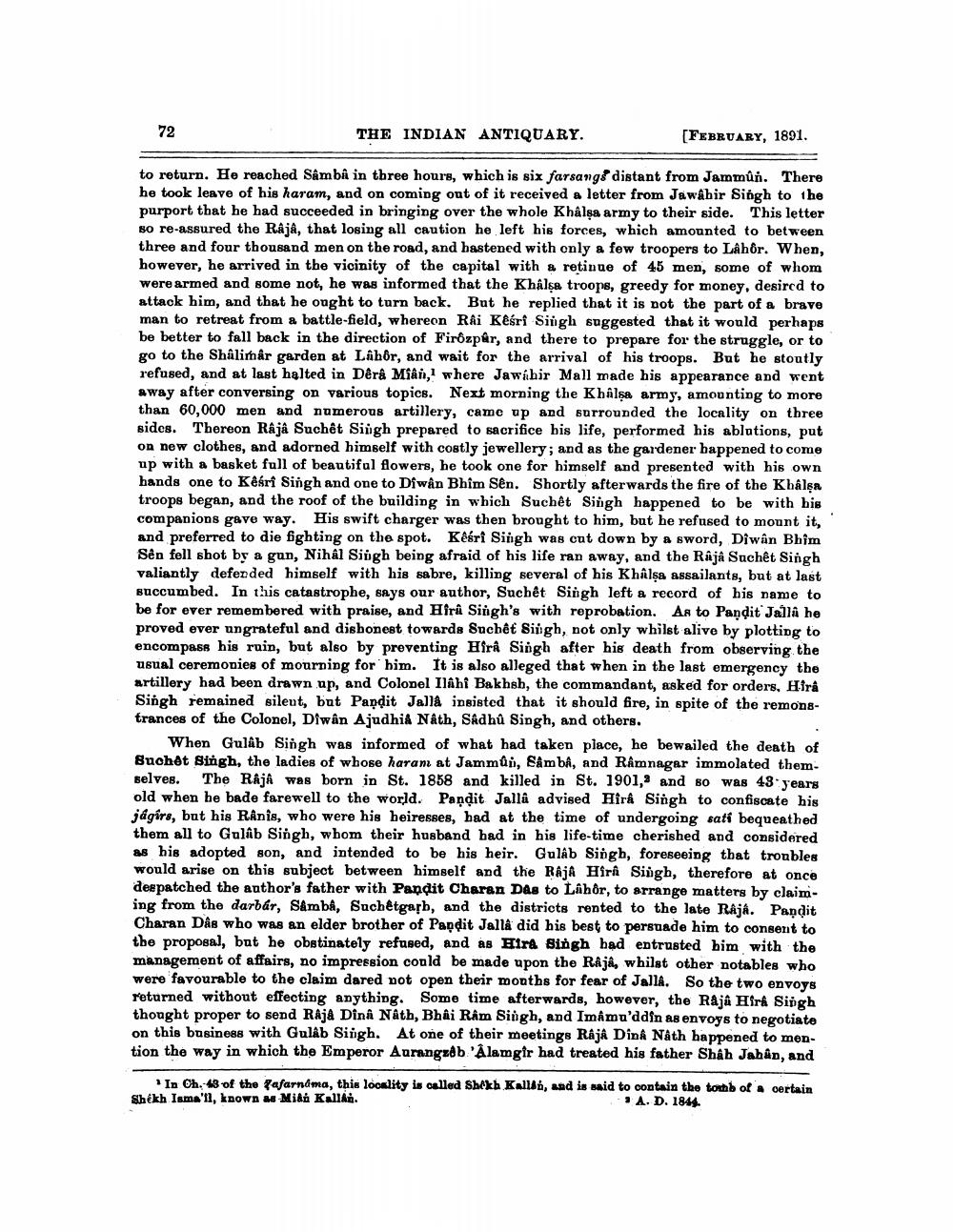________________
72
THE INDIAN ANTIQUARY.
[FEBRUARY, 1891.
to return. He reached Samba in three hours, which is six farsangs distant from Jammún. There he took leave of his haram, and on coming out of it received a letter from Jawahir Singh to the purport that he had succeeded in bringing over the whole Khâlşa army to their side. This letter 80 re-assured the Raja, that losing all caution he left his forces, which amounted to between three and four thousand men on the road, and hastened with only a few troopers to Lahôr. When, however, he arrived in the vicinity of the capital with & retinue of 45 men, some of whom were armed and some not, he was informed that the Khalsa troops, greedy for money, desired to attack him, and that he ought to turn back. But he replied that it is not the part of a brave man to retreat from a battle-field, whereon Râi Kêśri Singh suggested that it would perhaps be better to fall back in the direction of Firôzper, and there to prepare for the struggle, or to go to the Shalimar garden at Lahor, and wait for the arrival of his troops. But he stoutly refused, and at last halted in Dêrê Miân, where Jawahir Mall made his appearance and went away after conversing on various topics. Next morning the Khâlşa army, amounting to more than 60,000 men and numerous artillery, came up and surrounded the locality on three sides. Thereon Rââ Suchet Singh prepared to sacrifice his life, performed his ablutions, put on new clothes, and adorned himself with costly jewellery; and as the gardener happened to come up with a basket full of beautiful flowers, he took one for himself and presented with his own hands one to Késri Singh and one to Díwân Bhîm Sên. Shortly afterwards the fire of the Khâlşa troops began, and the roof of the building in which Suchêt Singh happened to be with his companions gave way. His swift charger was then brought to him, but he refused to mount it, and preferred to die fighting on the spot. Kêśri Singh was cut down by a sword, Diwan Bhim Sên fell shot by a gun, Nihal Singh being afraid of his life ran away, and the Raja Suchết Singh valiantly defended himself with his sabre, killing several of his Khalsa assailants, but at last succumbed. In this catastrophe, says our author, Suchêt Singh left a record of his name to be for ever remembered with praise, and Hira Singh's with reprobation. An to Pandit Jalla he proved ever ungrateful and dishonest towards Suchết Siugh, not only whilst alive by plotting to encompass his ruin, but also by preventing Hirê Singh after his death from observing the usual ceremonies of mourning for him. It is also alleged that when in the last emergency the artillery had been drawn up, and Colonel Ilahi Bakhsh, the commandant, asked for orders, Hira Singh remained silent, but Pandit Jalla insisted that it should fire, in spite of the remonstrances of the Colonel, Diwîn AjudhiA Náth, Sadhu Singh, and others.
When Gulab Singh was informed of what had taken place, he bewailed the death of Buchet Singh, the ladies of whose haram at Jammûn, Sâm bâ, and Ramnagar immolated themBelves. The RAJA was born in St. 1858 and killed in St. 1901, and so was 43 years old when he bade farewell to the world. Pandit Jallâ advised Hira Singh to confiscate his jágírs, but his Rinis, who were his heiresses, bad at the time of undergoing sati bequeathed them all to Gulab Singh, whom their husband had in his life-time cherished and considered as his adopted son, and intended to be his heir. Gulab Singh, foreseeing that tronbles would arise on this subject between himself and the Raja Hiran Singh, therefore at once despatched the author's father with Pandit Charan Das to Lahor, to srrange matters by claiming from the darbár, Sâmbâ, Suchêtgarh, and the districts rented to the late Raja. Pandit Charan Dås who was an elder brother of Papdit Jallâ did his best to persuade him to consent to the proposal, but he obstinately refused, and as Hira Singh bad entrusted him with the management of affairs, no impression could be made upon the Rajâ, whilst other notables who were favourable to the claim dared not open their months for fear of Jalla. So the two envoys returned without effecting anything. Some time afterwards, however, the Raja Hira Singh thought proper to send Raja Dinâ Náth, Bhai Ram Singh, and Imâmu'ddin as envoys to negotiate on this business with Gulab Singh. At one of their meetings Raja Dina Nath happened to mention the way in which the Emperor Aurangzeb 'Alamgir had treated his father Shah Jahan, and
In Ch. 48 of the fafarnama, this looklity is called Shekh Kallas, and is said to contain the tomb of Shekh Isma', known as Mika Kallan.
A. D. 1844
certain




